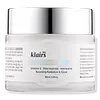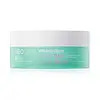What's inside
What's inside
 Key Ingredients
Key Ingredients

 Benefits
Benefits

 Concerns
Concerns

 Ingredients Side-by-side
Ingredients Side-by-side

Water
Skin ConditioningGlycerin
HumectantButylene Glycol
HumectantTocopheryl Acetate
AntioxidantNiacinamide
SmoothingSodium Hyaluronate
HumectantCarrageenan
Gellan Gum
Betaine
HumectantAlgin
MaskingMannan
Ceramide NP
Skin ConditioningPEG-60 Hydrogenated Castor Oil
EmulsifyingAcrylates/C10-30 Alkyl Acrylate Crosspolymer
Emulsion StabilisingChlorphenesin
AntimicrobialArginine
MaskingEthylhexylglycerin
Skin ConditioningCentella Asiatica Extract
CleansingRubus Fruticosus Fruit Extract
AstringentSalicornia Herbacea Extract
Skin ConditioningPhragmites Communis Extract
Skin ConditioningAdenosine
Skin ConditioningLavandula Angustifolia Oil
MaskingEucalyptus Globulus Leaf Oil
PerfumingPelargonium Graveolens Flower Oil
MaskingCitrus Limon Peel Oil
MaskingCitrus Aurantium Dulcis Peel Oil
MaskingCananga Odorata Flower Oil
MaskingWater, Glycerin, Butylene Glycol, Tocopheryl Acetate, Niacinamide, Sodium Hyaluronate, Carrageenan, Gellan Gum, Betaine, Algin, Mannan, Ceramide NP, PEG-60 Hydrogenated Castor Oil, Acrylates/C10-30 Alkyl Acrylate Crosspolymer, Chlorphenesin, Arginine, Ethylhexylglycerin, Centella Asiatica Extract, Rubus Fruticosus Fruit Extract, Salicornia Herbacea Extract, Phragmites Communis Extract, Adenosine, Lavandula Angustifolia Oil, Eucalyptus Globulus Leaf Oil, Pelargonium Graveolens Flower Oil, Citrus Limon Peel Oil, Citrus Aurantium Dulcis Peel Oil, Cananga Odorata Flower Oil
Water
Skin ConditioningHydrogenated Olive Oil Lauryl Esters
Emulsion StabilisingCetyl Ethylhexanoate
Emollient1,2-Hexanediol
Skin ConditioningGlycerin
HumectantNeopentyl Glycol Diheptanoate
EmollientCamellia Sinensis Leaf Extract
AntimicrobialAscorbic Acid
AntioxidantCyclopentasiloxane
EmollientCetearyl Alcohol
EmollientGlyceryl Stearate
EmollientPEG-100 Stearate
Palmitic Acid
EmollientDimethicone
EmollientAmmonium Acryloyldimethyltaurate/Vp Copolymer
Stearic Acid
CleansingCyclohexasiloxane
EmollientCetyl Alcohol
EmollientStearyl Alcohol
EmollientCetearyl Glucoside
EmulsifyingCoptis Japonica Extract
AntimicrobialTrehalose
HumectantButylene Glycol
HumectantEthylhexylglycerin
Skin ConditioningDimethicone/Vinyl Dimethicone Crosspolymer
Skin ConditioningGardenia Florida Fruit Extract
Skin ConditioningAllantoin
Skin ConditioningGlucose
HumectantMaltodextrin
AbsorbentSodium Hyaluronate
HumectantPanthenol
Skin ConditioningDisodium EDTA
Water, Hydrogenated Olive Oil Lauryl Esters, Cetyl Ethylhexanoate, 1,2-Hexanediol, Glycerin, Neopentyl Glycol Diheptanoate, Camellia Sinensis Leaf Extract, Ascorbic Acid, Cyclopentasiloxane, Cetearyl Alcohol, Glyceryl Stearate, PEG-100 Stearate, Palmitic Acid, Dimethicone, Ammonium Acryloyldimethyltaurate/Vp Copolymer, Stearic Acid, Cyclohexasiloxane, Cetyl Alcohol, Stearyl Alcohol, Cetearyl Glucoside, Coptis Japonica Extract, Trehalose, Butylene Glycol, Ethylhexylglycerin, Dimethicone/Vinyl Dimethicone Crosspolymer, Gardenia Florida Fruit Extract, Allantoin, Glucose, Maltodextrin, Sodium Hyaluronate, Panthenol, Disodium EDTA
 Reviews
Reviews

Ingredients Explained
These ingredients are found in both products.
Ingredients higher up in an ingredient list are typically present in a larger amount.
Butylene Glycol (or BG) is used within cosmetic products for a few different reasons:
Overall, Butylene Glycol is a safe and well-rounded ingredient that works well with other ingredients.
Though this ingredient works well with most skin types, some people with sensitive skin may experience a reaction such as allergic rashes, closed comedones, or itchiness.
Learn more about Butylene GlycolEthylhexylglycerin (we can't pronounce this either) is commonly used as a preservative and skin softener. It is derived from glyceryl.
You might see Ethylhexylglycerin often paired with other preservatives such as phenoxyethanol. Ethylhexylglycerin has been found to increase the effectiveness of these other preservatives.
Glycerin is already naturally found in your skin. It helps moisturize and protect your skin.
A study from 2016 found glycerin to be more effective as a humectant than AHAs and hyaluronic acid.
As a humectant, it helps the skin stay hydrated by pulling moisture to your skin. The low molecular weight of glycerin allows it to pull moisture into the deeper layers of your skin.
Hydrated skin improves your skin barrier; Your skin barrier helps protect against irritants and bacteria.
Glycerin has also been found to have antimicrobial and antiviral properties. Due to these properties, glycerin is often used in wound and burn treatments.
In cosmetics, glycerin is usually derived from plants such as soybean or palm. However, it can also be sourced from animals, such as tallow or animal fat.
This ingredient is organic, colorless, odorless, and non-toxic.
Glycerin is the name for this ingredient in American English. British English uses Glycerol/Glycerine.
Learn more about GlycerinSodium Hyaluronate is hyaluronic acid's salt form. It is commonly derived from the sodium salt of hyaluronic acid.
Like hyaluronic acid, it is great at holding water and acts as a humectant. This makes it a great skin hydrating ingredient.
Sodium Hyaluronate is naturally occurring in our bodies and is mostly found in eye fluid and joints.
These are some other common types of Hyaluronic Acid:
Learn more about Sodium HyaluronateWater. It's the most common cosmetic ingredient of all. You'll usually see it at the top of ingredient lists, meaning that it makes up the largest part of the product.
So why is it so popular? Water most often acts as a solvent - this means that it helps dissolve other ingredients into the formulation.
You'll also recognize water as that liquid we all need to stay alive. If you see this, drink a glass of water. Stay hydrated!
Learn more about Water